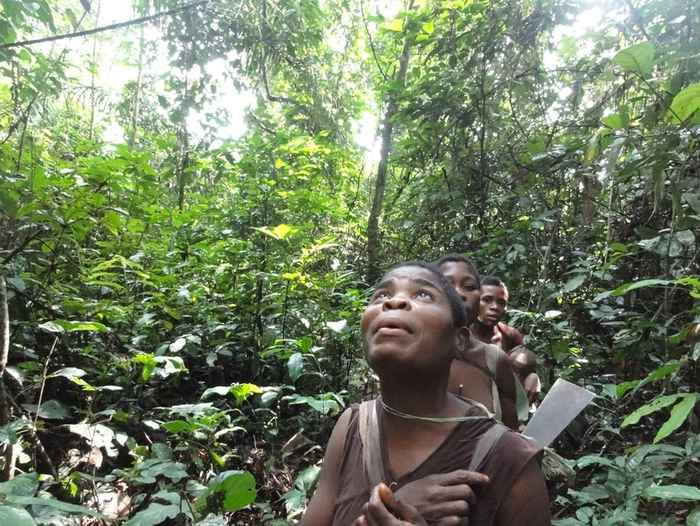How humans and chimpanzees travel towards a goal in rainforests
Linearity in travel increases in humans when they travel in increasingly large groups, while chimpanzees travel more goal-directed when they are on their own
30 July 2019

Humans are unique among the great apes in their ranging style: the way they move through a landscape. The BaYaka people from the Republic of Congo move from camp to camp every few months, and thus have a large life-time range size of approximately 800 km2. Their core area is restricted around the trails that they create. In contrast, one of our closest living relatives, chimpanzees, live in a relatively smaller area (25 km2) and spend most of their adult lives in the same home range.
Humans collect food and consume it in their camp where they sleep, while chimpanzees consume food as it is encountered, rarely use repeated paths when travelling on the ground and make sleeping nests at variable locations within their home range. These different ranging styles between humans and chimpanzees might shape differential spatial experience and thus the way they travel through the forest to find food in their natural habitats.
Food search
Karline Janmaat, researcher at the UvA Institute for Biodiversity and Ecosystem Dynamics (IBED) and her colleagues from the Max Planck Institute for Evolutionary Anthropology set out to study how human foragers and chimpanzees compare in their spatial performances in a similar rainforest environment. To this aim, the researchers measured travel linearity and speed of five BaYaka women from the Republic of Congo and five female chimpanzees in Taï forest, Côte d’Ivoire, when they travelled off-trail areas to out-of-sight food locations during their daily search for food in the rainforest. It is the first study that recorded and analysed the ranging patterns of both humans and chimpanzees using the same data collection.
The research team found that both the BaYaka people and Taï chimpanzees had, on average, similarly high levels of linearity and speed when they travelled towards out-of-sight locations. However, they also found that the BaYaka people and Taï chimpanzees clearly differed in the manner in which their travel linearity and speed changed with group size and familiarity with a foraging area. BaYaka people travelled with higher linearity in familiar areas compared to less familiar areas. This pattern was reversed in Taï chimpanzees, in which they moved with higher linearity and speed in less familiar areas compared to familiar areas.

‘One possible explanation of these differences lays in their different ranging style. The BaYaka people stay in several seasonal camps in their lifetime range and walk 90 percent of their travel distance on human-made trails during their foraging trips in the forest. They may therefore have less experience in less familiar off-trail areas. Hence, when the BaYaka people forage in these areas, their travel linearity decreases due to their searching effort, explains PhD candidate Haneul Jang, lead author of the study.
On the contrary, chimpanzees decreased travel linearity and speed in more familiar areas. Jang continues: ‘Since chimpanzee groups can be highly hostile towards each other, they might need to travel more efficiently and faster in less familiar areas, where they are more likely to encounter other chimpanzee groups.’
Group size
The researchers found that the BaYaka people increased travel linearity when they travelled in a larger foraging group compared to a smaller group, whereas Taï chimpanzees decreased travel linearity when they were in a larger foraging group. ‘When I followed the chimpanzees, I often saw them waiting for each other and having apparent disagreements about where to go’, says Janmaat. ‘With more individuals joining the group, this disagreement seemed to increase. It is therefore perhaps not surprising that when group size was large, their travel became less linear.
‘For the BaYaka people we found the opposite. This can have many reasons, but I like to think that it is because humans can discuss, evaluate and eventually agree about where the best food sources are through language and that this helped them to travel more efficiently. Language may have facilitated an efficient evaluation of differential information,’ explains Janmaat.
According to the authors, this study is the first necessary step needed to compare long-range spatial movement patterns of human and chimpanzee populations in their natural habitats. ‘Our study provides an insight into how two closely related species living in similar environments can differ in their spatial movement patterns, which possibly results from their different ranging styles.’, concludes Jang. ‘We hope that our study can contribute to expanding comparative research on spatial movement patterns to a wide range of primate species and populations in natural environments.’
Publication details
Haneul Jang, Christophe Boesch, Roger Mundry, Simone D. Ban, and Karline R. L. Janmaat. Travel linearity and speed of human foragers and chimpanzees during their daily search for food in tropical rainforests. Scientific Reports, July 2019